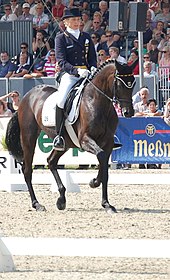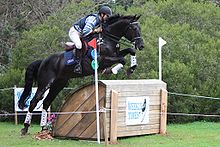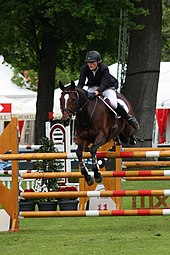Eventing riding

The versatility , now also Eventing called earlier than Military designated, is a discipline of equestrian sport .
The versatility is a multi-discipline , consisting of the three partial tests dressage , cross country riding and jumping there. Internationally, versatility is known in French as Concours Complet or CC for short .
history
The military, as its name suggests, was developed by the military and geared towards its needs at the time. It emerged from the cavalry training program and was discarded at the end of the training for rider and horse . The test was also important for the selection of horses for breeding for military use.
Horses
A good eventing horse has to be rideable and reliable. It must be able to concentrate in the dressage test and not be distracted. For the cross-country course it has to be athletic and have the necessary courage and high motivation. An expansive gallop and stamina should be available as well as a resilient horse and good eyesight for distances. Despite all the hardness, you shouldn't be careless about jumps, as this can quickly lead to unnecessary drops in the jumping competition.
Warm-blooded animals with a high percentage of whole blood dominate the higher classes today . Even pure thoroughbreds can still be found in top-class sport, but less than in previous decades.
equipment
The correct suits must be worn in dressage and jumping. In all sub-disciplines, a maximum of 3.5 cm long spurs may be used.
Lighter clothing with boots is allowed for the cross-country course. A riding helmet and a safety vest must be worn for this. This must meet the standards of the British Equestrian Trade Association (BETA 3 standard). Combinations of standard vests with airbag vests are also allowed. A medical card with important information for emergency medical care on the upper arm or boot shaft is also required for international exams .
The horse's legs are protected with gaiters in the field and when jumping . Studs under the horseshoes , usually screw studs, ensure better grip at high speeds and on slippery ground. A mixture of petroleum jelly and lubricant is usually applied to the horse's legs and sometimes the lower body parts to reduce the risk of superficial injuries. When riding off-road, a stopwatch is usually worn in order to be able to check the pace using waypoints.
exams
Constitutional Examination
In addition to the three partial exams, there is a constitutional examination after the cross-country ride. It checks whether the horse is uninjured, whether the resting heart rate is reached again within a limited period, whether the horse is not dehydrated and whether there is no lameness. At major international competitions there is an additional constitutional test before dressage. If a horse fails one of the two constitutional tests, it will be excluded from the competition.
Furthermore, every member of the judging group can order a constitutional examination during the examination. If the jury considers a horse to be overwhelmed or dangerously exhausted in the cross-country course, the rider is informed of the concerns with a yellow flag. If the risk increases in the eyes of the jury, the starter couple can be removed from the test with immediate effect, which is indicated by a red flag.
dressage
The dressage task always forms the beginning of an eventing test. The result achieved in the dressage test can no longer be improved in the other partial tests , but can only be maintained by being free of errors. In dressage and jumping, less demands are made in terms of versatility than in the individual disciplines of the corresponding performance class. This takes into account the other performance profile of the eventing horses.
Cross-country ride
The obstacle dimensions, safety and criticism of the cross-country route are described in
The terrain obstacles are smaller in terms of height and width compared to specialized show jumping. The difficulty arises from the integration into the terrain. For example, a 1.20 m wall rises directly behind a 1 m deep ditch, apparently over 2 m high. Landing in the water or jumping out of the water or landing point at a different height than the jump make the jumps difficult. A coffin is a ditch in a depression with cracks. The appearance influences the difficulty of obstacles (e.g. mighty tree trunks, piles of wood and solid wooden walls, some of which are almost free-floating).
There are special requirements for obedience when the horse has to jump over a very narrow jump that it could comfortably walk past sideways. Some obstacles are stimulating in appearance, such as market stalls with fruit and flowers.
In the case of difficult stretches of particularly difficult passages, there are usually two alternative routes to choose from, one of which is less demanding, but takes more time to overcome and is colloquially called the chicken way . In this way, the rider can independently adapt the route to the form of the day, as well as the strengths and weaknesses of his horse. There are also obstacles, the connections of which give way under a certain load or can be easily dismantled manually. This is to limit the consequences of falls and facilitate rescue.
Leap
The jumping competition always forms the end of the versatility test. The jumping course is less technical because the obstacles it contains are no higher than 1.30 m and the distances between the jumps are longer, as the horses have to be trained for a larger gallop jump for the cross-country ride . With solid obstacles, contact is not a problem, which leads to throws in the course. In the case of difficult versatility, they correspond to medium-difficulty dressage and jumping tasks for specialists (class M). Obstacle requirements in international exams:
| class | height | Width (depth) oxer | Width (depth) triple bars |
|---|---|---|---|
| CCI 1 * | 1.10 m | 1.25 m | 1.45 m |
| CCI 2 * | 1.15 m | 1.35 m | 1.55 m |
| CCI 3 * | 1.20 m | 1.40 m | 1.60 m |
| CCI 4 * | 1.25 m | 1.45 m | 1.65 m |
| CCI 5 * | 1.30 m | 1.45 m | 1.65 m |
Difficulty levels
Events of various degrees of difficulty are advertised. For international exams , a distinction is made between short exams and long exams . The difficulty of the given tasks is rated using a classification from one to five stars. There are six CCI 5 * long-term exams worldwide.
The difference between short and long exams in tournaments lies on the one hand in the design of the terrain and on the other in the total duration of the test. In the case of long tests, a significantly longer cross-country route has to be mastered.
In short tests, both the terrain test and the jumping test can conclude the event. Short exams usually take place as an exam over one or two days, with long exams the program is usually spread over three days (hence the internationally common name of three day event for long exams).
rating
The overall rating of an event is based on fault points (also called minus points).
The dressage result is converted into points of error, with lower scores mean a better result. From the beginning of 2018 this is done by subtracting the dressage result from 100 (with a dressage result of 75 percent this would be 100 - 75, i.e. 25 error points). Up to 2017 a coefficient of 1.5 was applied. It was calculated in steps of 1.5: 0 fault points correspond to a dressage test of 100%, 15 fault points 90%, 30 fault points 75%, etc. The world's best in sport often had less than 30 fault points with their dressage results. Due to the rule change, the dressage test lost its influence on the overall result.
In addition, there are obstacle and time errors from terrain and jumping, whereby obstacle errors in terrain are credited with 20 error points and more (e.g. for dangerous riding ), but only with 4 error points in jumping. Exceeding the given time on the cross-country course leads to penalty points, however, undercutting does not lead to plus points, but only to increased fatigue of the rider and horse. In the field, mistakes and falls that occur in connection with an obstacle count . A fall of the horse in connection with an obstacle leads to immediate exclusion from international tests in order to protect the horse.
The winner is the pair with the lowest number of faulty points after the three sub-disciplines. No points are awarded in the constitutional examination.
At championships ( European Championships , World Equestrian Games and Olympic Games ) four or five pairs per country or NOK are allowed to start. As in other disciplines, the three best individual results are counted as team results.
International championships
The highlight of eventing is the Summer Olympics . The Olympic champions in eventing have been determined since 1912 .
Two years after the Summer Olympics, the World Equestrian Games have been held since 1990 , which also include the World Championships in eventing. Before that, the world champions were determined at an independent event.
The European championship in eventing has been held in Europe since 1953 . These have been held every two years since 1965, in the odd years. Similar competitions are for the Americas, the Pan American Games as well as Asia, the Asian Relations games .
Olympic history
Military in the Olympic Games until 2000
At the Olympic premiere in Stockholm in 1912 , already with a team competition, only officers were allowed to participate. The exam lasted several days:
- Day 1: Endurance test 55 km on trails and race tracks (allowed time 4 hours; specified speed: 230 m / min), followed by a cross-country of 5 km at a specified speed of 333 m / min. Penalty points for exceeding the time, riding faster had no effect on the result.
- Day 2: rest day
- Day 3: Obstacle race ( steeplechase ) over 3.5 km with 10 jumps, specified speed: 600 m / min, penalty points if you exceeded the time, riding faster had no effect on the result.
- Day 4: rather easy jumping competition
- Day 5: Dressage test
In Antwerp 1920 , so-called gentlemen riders also took part. There was no dressage, but two cross-country rides over 20 kilometers on the first and 50 kilometers on the second day.
For the Games in Paris in 1924 , new regulations were introduced that are more similar to today's 3-day test: day 1 dressage test, day 2 endurance test and on day 3 jumping competition. The endurance test was composed as follows:
- Phase A: short distance with 5 penalty points for every 5 seconds exceeded
- Phase B: Obstacle race ( steeplechase ), specified speed 550 m / min, 10 penalty points for every 5 seconds exceeded, 3 points credit for every 5 seconds shortfall
- Phase C: long distance with 5 penalty points for every 5 seconds exceeded
- Rest break
- Phase D: Cross-country route, 10 penalty points for each 5 s time limit, 3 points were awarded for each 10 s time limit
- Phase E: Quarter mile (402.34 m) on a flat route with 5 penalty points for every 5 seconds exceeded
In 1963, the rest period after phase C was set at 10 minutes, which is spent in the 10-minute box . The horse is cooled down , cared for and checked by a veterinarian to see whether it is approved for the cross-country route or has to be excluded. In Tokyo 1964 a woman was allowed to participate for the first time. You are integrated into the teams.
Phase E was abolished in 1967.
In 1971 there was no longer any possibility of gaining points by riding faster and more accurately on the obstacle course and off-road course.
Olympic Games since 2004
After a few deaths and serious injuries to riders and horses during cross-country riding in the 1990s , the eventuality in the Olympic program was endangered. Serious accidents were particularly frequent at the Olympic Games in Sydney in 2000, as the difficulty of the cross-country track was dimensioned in such a way that it was a serious challenge to the top of the world, with clear results over the rest of the field. At the same time, however, numerous non-world-class couples started for foreign countries and were sometimes not up to the requirements. To counteract this, the format was changed at the Olympic Games in Athens in 2004 , the terrain section there was limited to the pure cross-country course with fixed obstacles and was about five kilometers long. Neither the routes nor a racetrack had to be completed. This is to reduce the risk of serious accidents when technically difficult passages come together with heavily tired horses.
Since then, this mode has become increasingly widespread in non-Olympic top-level competitions and has evidently proven its worth in view of the falling accident figures. Due to the current regulations, only starter couples who had successfully taken a CCI / CIC *** test by May 2008 at the latest were allowed to take part in the 2008 Olympic test in Hong Kong .
Rule changes in 2017
Since January 2017, the allocation of penalty points for cross-country rides has been changed. There are now 50 penalty points if an obstacle outside the obstacle limit (the flags) is overcome. Previously this was punished with disqualification. If the jump is done correctly again, only 20 penalty points are imposed. In the past, the obstacle judge could be asked whether someone jumped outside of the flag, today this is punished as outside help with disqualification.
Web links
- CDV-Club Deutscher Verseitigkeitsreiter e. V. - Specialist group versatility in the German Rider and Driver Association (DRFV)
- FEI rules for international eventing (English)
Individual evidence
- ↑ German Equestrian Association - Eventing Riding
- ↑ Can Thoroughbreds still win at the CCI4 * level? , Eventing Connect, April 30, 2015
- ↑ spiegel.de June 15, 2014: Fatal fall in eventing: "There will never be one hundred percent security" , interview by Olaf Stampf with Martin Plewa
- ↑ Eventing Rules, 25th Edition, effective 1st January 2019 , Annex C Jumping - Annexes (PDF)
- ↑ Important changes also decided for the versatility in the international area , buschreiter.de
- ↑ Versatility: New FEI rules
- ↑ 10 minutes booklet
- ^ Horse and Olympia , FN Verlag
- ^ The first women in the "Men's Club" (2nd part) , Max E. Ammann / Horse Week , May 3, 2016
- ↑ Eventing Rules 2017 highlighted ( Memento of July 3, 2017 in the Internet Archive ), FEI, accessed on June 10, 2017




